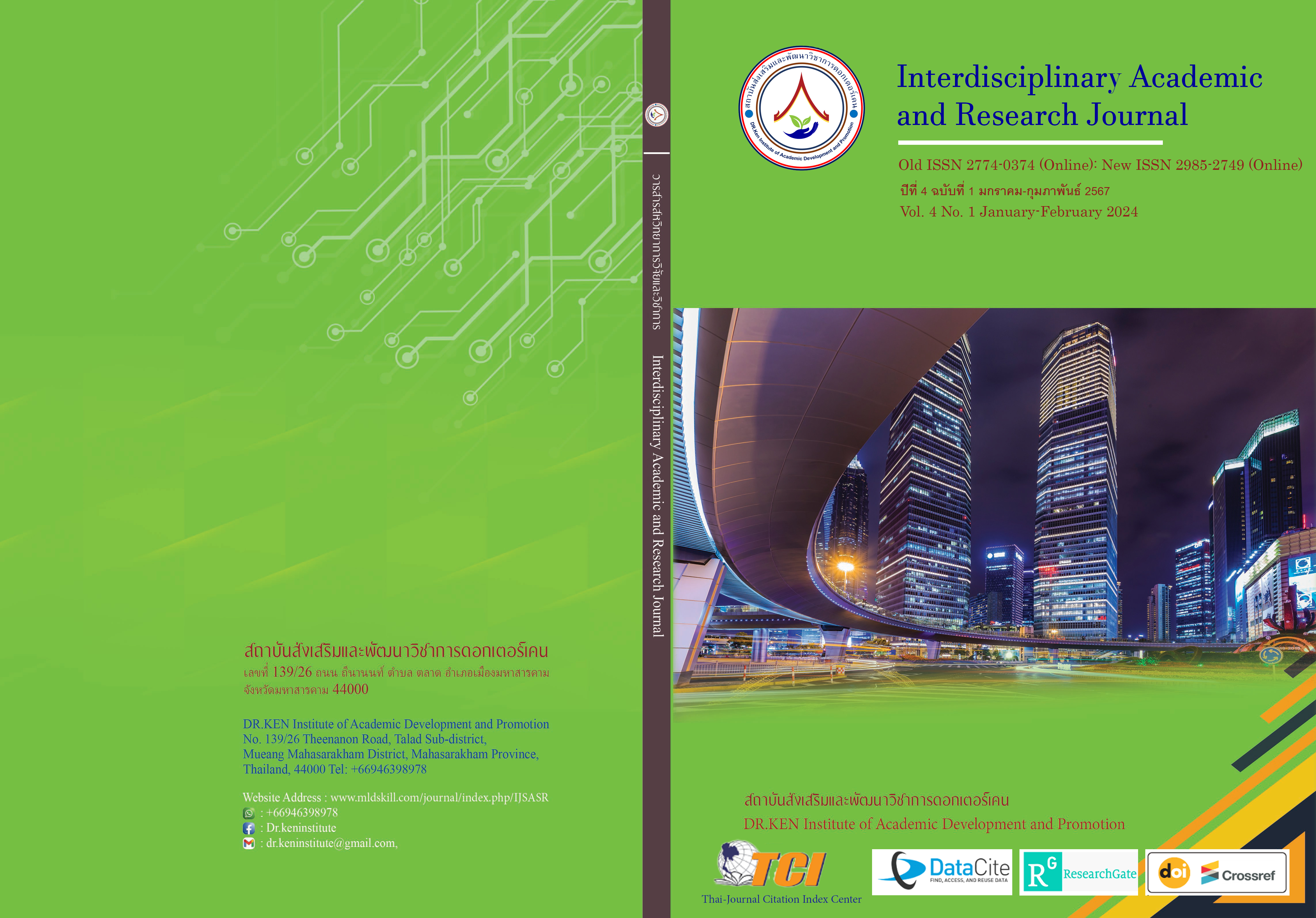Development of Innovative Marketing Communication for Products Distribution of Chom Phra Fishery Community
DOI:
https://doi.org/10.60027/iarj.2024.273086Keywords:
Innovation; , Marketing Communication; , Community Products; , Rhythmic Pacing StudentAbstract
Background and Aims: Community products are unique products that are produced by the community, which uses raw materials available in the community and uses knowledge from local wisdom to create uniqueness for the products, most of which are handicraft products. There is also food and food processing which are community products that are produced in large quantities according to the geography and culture of the community. Thus, this research aims (1) to study the problems and needs of the Chom Phra fishery community in terms of products, use of social media marketing communication, public relations, and marketing communication model of Chom Phra fishery community products, and (2) to develop marketing communication innovations to sell products of Chom Phra fishery community 3) to assess the quality of marketing communication innovations in the Chom Phra fishery community.
Methodology: Key informants include: The essential informants in Objective 1 were 5 Chom Phra community leaders and 20 Chom Phra fishery community product group members, a total of 25 people, using purposive random sampling. The group of informants in objective two was composed of six experts using purposive random sampling. The sampling group assessing the quality of the innovation consisted of 152 people from the Chom Phra fishery community, using simple random sampling. The research tools were structured interviews—issues in group discussions—and questionnaires. The data were analyzed by content analysis, and descriptive statistics consisted of percentage, mean, and standard deviation.
Results: The results showed that most Chom Phra villagers make a living as fishermen, and fresh fish is obtained from fishing because the Huai Thap Than River flows through. Villagers gather to process fish from their fishery. However, the products could be better known. Most are sold at the Bueng Bun district fresh market, tourist rafts, and village acquaintances. Villagers can use social media such as Facebook, Line, and TikTok. Group members want to publicize and sell products through social media to generate revenue and sales through such channels. The innovative marketing communications developed include posters, video clips, and content marketing to promote on Facebook, websites, and YouTube. The results of the quality assessment of marketing communication innovations were found to be at the highest level in all aspects, in terms of meeting users' needs, functionality, and suitability for use.
Conclusion: Chom Phra villagers talk about fishing and processing fish into 4 main products: Marinated fish, Marinated fish hatched, Banded fish, and Marinated fish eggs that are often sold in the Bueng Burapha district fresh market, Subdistrict Administrative Organization doctors, and if in the village Can use social media such as Facebook, Line, and marketing to promote and sell products. Increase income and sales Marketing communication innovations developed include posters, video clips, and marketing.
References
กฤษณะ แสงจันทร์ และสหัทยา สิทธิวิเศษ. (2564). การพัฒนาทักษะการผลิตสื่อจากสมาร์ทโฟนเพื่อสื่อสารการตลาดของวิสาหกิจชุมชนในจังหวัดเชียงราย. วารสารวิทยาการจัดการ มหาวิทยาลัยราชภัฏเชียงราย, 16(2), 150-177.
จุฑารัตน์ พรหมทัต. (2564). สร้างแบรนด์ชุมชน เสริมแกร่งให้เศรษฐกิจฐานราก. กรุงเทพฯ: กลุ่มพัฒนาเศรษฐกิจฐานราก กองนโยบายการสร้างความเข้มแข็งทางการค้า สำนักงานนโยบายและยุทธศาสตร์การค้า
ชื่นจิตต์ แจ้งเจนกิจ. (2548). กลยุทธ์สื่อสารการตลาด. พิมพ์ครั้งที่ 5. พิฆเณศพริ้นติ้ง เซ็นเตอร์ จำกัด.
ณิชาภา ศรีคุณารักษ์. (2565). การสื่อสารการตลาดที่มีอิทธิพลต่อการตัดสินใจซื้ออาหารทะเล ของผู้บริโภคในเขตกรุงเทพมหานคร. วิทยานิพนธ์ปริญญาโทที่ไม่มีการตีพิมพ์: มหาวิทยาลัยสงขลานครินทร์.
พิมานรัตน์ วงศ์กาฬสินธุ์. (2563). อิทธิพลของการสื่อสารการตลาดออนไลน์ต่อทัศนคติบรรทัดฐานของกลุ่มอ้างอิงและความตั้งใจที่จะใช้บริการร้านตัดผมชายแบบเดลิเวอรี่ในกรุงเทพมหานคร. วิทยานิพนธ์ปริญญาโทที่ไม่มีการตีพิมพ์: มหาวิทยาลัยเกษตรศาสตร์.
เพชรพันธ์ สุพรรณฝ่าย. (2554). ปัจจัยที่ส่งผลต่อการผลิตและการจัดการผลผลิตของผลิตภัณฑ์จากกก ตำบลแพง อำเภอโกสุมพิสัย จังหวัดมหาสารคาม. การศึกษาอิสระปริญญาเศรษฐศาสตรมหาบัณฑิต: มหาวิทยาลัยขอนแก่น.
ภัทรพล ชุ่มมี. (2565). การวิเคราะห์การสื่อสารการตลาดแบบบูรณาการของวิสาหกิจชุมชน จังหวัดปทุมธานี. Journal of Modern Learning Development, 7(8), 287-299.
วารุณี ตันติวงศ์วาณิช และคณะ. (2545). หลักการตลาด. เพียร์สัน เอ็ดดูเคชั่น อินโดไชน่า.
ศิริวุฒิ วรรณทอง. (2566). การจัดการทุนชุมชนประมงพื้นบ้าน บ้านจอมพระ ตำบลบึงบูรพ์ อำเภอบึงบูรพ์ จังหวัดศรีสะเกษ เพื่อส่งเสริมอาชีพประมงพื้นบ้านโดยชุมชนมีส่วนร่วม. มหาวิทยาลัยราชภัฏศรีสะเกษ.
อัจจิมา ศุภจริยาวัตร. (2565). แนวทางการพัฒนาผลิตภัณฑ์ชุมชนเพื่อการส่งออก กรณีศึกษากลุ่มผ้าไหมทอมือบ้านสุขสำราญ จังหวัดสระแก้ว. วารสารศิลปศาสตร์และอุตสาหกรรมการบริการ, 5(1), 429.
Armstrong, G. (1999). Principles of Marketing. 8th edition. Prentice-Hall. Inc.
Fill, C. (1999). Marketing Communications: Contexts, Contents and Strategies. 2nd edition. Prentice-Hall Europe.
Gardener, E., & Trivedi, M. (1998), A communication framework to evaluate sale promotion strategies. J. Advert. Res., 38(3), 67-71.
Kotler, P. (2003). Marketing management. 11th edition. Upper Saddle River, NJ: Prentice-Hall.
Kotler, P., & Keller, K.L. (2012). Marketing Management. 14th edition. Pearson Education.
Porter, M.E. (1985). Competitive Advantage. The Free Press.
Shimp, T.A. (1996). Promotion Management and Marketing Communications. The Dryden Press.
Yamane, T. (1973). Statistics: an introductory analysis. New York: Harper & Row.
Downloads
Published
How to Cite
Issue
Section
License
Copyright (c) 2024 Anansak Phuangok , Juntakan Panleow

This work is licensed under a Creative Commons Attribution-NonCommercial-NoDerivatives 4.0 International License.
Copyright on any article in the Interdisciplinary Academic and Research Journal is retained by the author(s) under the under the Creative Commons Attribution-NonCommercial-NoDerivatives 4.0 International License. Permission to use text, content, images, etc. of publication. Any user to read, download, copy, distribute, print, search, or link to the full texts of articles, crawl them for indexing, pass them as data to software, or use them for any other lawful purpose. But do not use it for commercial use or with the intent to benefit any business.
















.png)


